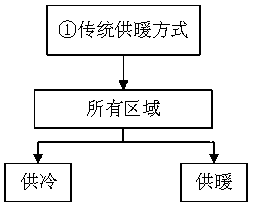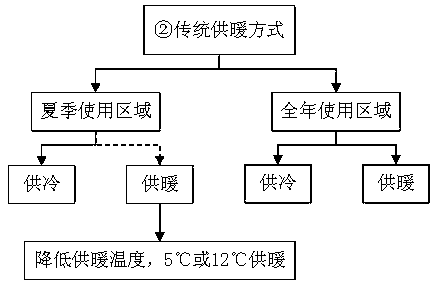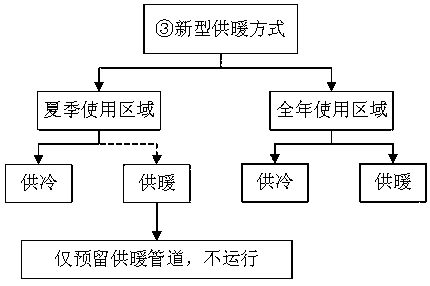Winter heating method for building
A technology for buildings and existing buildings, applied in the field of tourism buildings in the western plateau area, can solve the problems that the enclosure structure has little significance, the building utilization rate is very different, and the energy consumption is low in winter.
- Summary
- Abstract
- Description
- Claims
- Application Information
AI Technical Summary
Problems solved by technology
Method used
Image
Examples
Embodiment 1
[0062] for existing buildings
[0063] 1. Conduct research and analysis on the situation of the building
[0064] The research content includes the thermal parameters of the building envelope, the meteorological parameters of the building location, the annual utilization rate of the building, and the current energy consumption of the building (including water consumption, electricity consumption, and heating consumption).
[0065] 2. Analyze the usage of the building
[0066] Mainly analyze the usage difference between winter and summer based on the usage rate in recent years, and approximate the usage rate in winter according to the usage rate and changes in recent years.
[0067] Building utilization rate = Max(λ 1 ,λ 2 ,λ 3 ...λ n )
[0068] 3. Zoning of buildings based on calculated winter occupancy
[0069] Based on the usage rate in winter, the building is divided into two parts: one is an area that is used all year round; the other is an area that is only used in...
Embodiment 2
[0077] for new construction
[0078] 1. Investigate local changes in the annual tourist flow and the annual use of similar buildings
[0079] Investigate the changes in the local annual tourist flow and the annual use of similar buildings. The utilization rate of tourist buildings is closely related to the change in local tourist flow. At the same time, according to the use objects and levels of the building and the year-round use of similar buildings, the winter and summer use of the building is approximately estimated. Building utilization rate = Max(λ 1 ,λ 2 ,λ 3 ...λ n )
[0080] 2. Zoning or segmenting the building based on calculated winter occupancy
[0081] Based on the usage rate in winter, the building is divided into two parts: one is an area that is used all year round; the other is an area that is only used in summer. The area used throughout the year should meet the utilization rate in winter, and a certain margin should be left according to the changes in...
Embodiment 3
[0089] new building
[0090] 1. Building overview
[0091] The hotel is located in a tourist city on the Qinghai-Tibet Plateau, which belongs to the severe cold area C, with a total construction area of 10640m2 2 , a total of 7 floors, of which 1 floor is the hotel lobby and commercial rooms, the 2nd to 6th floors of the hotel are guest rooms, and the 7th floor is the restaurant (boxes and banquet halls). The total heating area is 10013m 2 .
[0092] 2. Usage calculation
[0093] Image 6 It is the occupancy rate of a local hotel of the same type and grade in the previous year. The heating season runs from October to April.
[0094] 3. Partition selection
[0095] Based on hotel occupancy rates, building occupancy during the heating season is roughly 41%. Combined with the hotel's architectural features and functional zoning, the building is zoning. The following zoning methods are provided below:
[0096] As shown in the figure below, the building is partitioned,...
PUM
 Login to View More
Login to View More Abstract
Description
Claims
Application Information
 Login to View More
Login to View More - R&D
- Intellectual Property
- Life Sciences
- Materials
- Tech Scout
- Unparalleled Data Quality
- Higher Quality Content
- 60% Fewer Hallucinations
Browse by: Latest US Patents, China's latest patents, Technical Efficacy Thesaurus, Application Domain, Technology Topic, Popular Technical Reports.
© 2025 PatSnap. All rights reserved.Legal|Privacy policy|Modern Slavery Act Transparency Statement|Sitemap|About US| Contact US: help@patsnap.com



